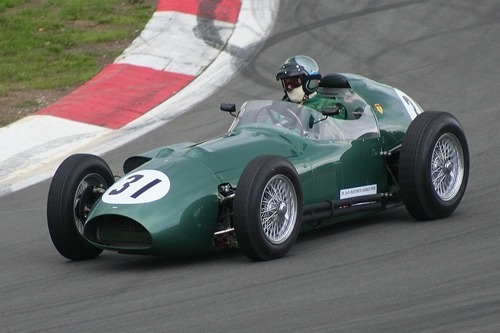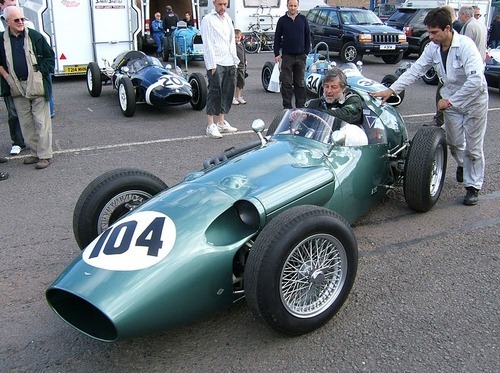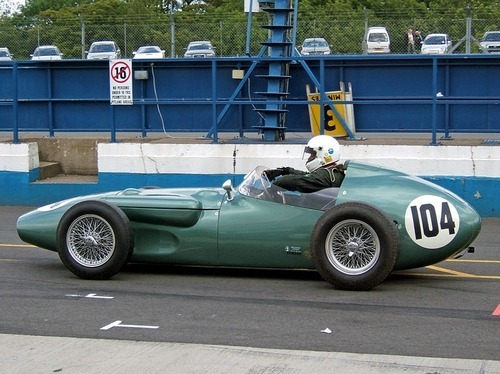
Unless you’ve been living under a rock for the past few days, you will have already heard the news that Aston Martin will be joining Red Bull Racing as a title sponsor. They won’t be making cars or engines just yet, but they have left the doors open for the near future. In honor of this, let’s look back at Aston Martin’s brief history as a Formula One constructor.
Having been already competing in sports cars at the 24 Hours of Le Mans, Aston Martin was looking take on the open wheel racing world. Plans were put in motion to design an open wheel Aston Martin in 1955. By early 1956, the company had designed a prototype, which was entered into a few open wheel races by their sports car driver Reg Parnell.

The prototype was successful and Aston Martin made the decision to enter Formula One. The project has various issues in the development stages, the largest being that the company was still largely focused on their sports car programme. Because of this, development on the Formula One car was frequently halted, as workers were moved to the sports car programme.
With no wind tunnel testing, the company was finally able to design a car for Formula One. Many design elements of the car were lifted from their successful DB3S sports car. Unfortunately, many concepts used in the car were outdated by many years. The car ran with a straight-six Aston Martin engine.
Nevertheless, two cars were built and debuted the public in the spring of 1959 as the Aston Martin DBR4. It made its racing debut in Silverstone for the BRDC International Trophy race in early May. Roy Salvadori was asked to race one of the cars. He had raced for primarily Maserati and Cooper. Carroll Shelby, the American auto designer best known for the Ford Mustangs that carry his name, was driving the other car.
The cars looked quite good, with Salvadori qualifying in P3 and Shelby in P6. On race day, Salvadori was able to better his starting position by one, finishing as one of three cars on the lead lap, ranking among the Cooper and BRM cars, while also beating a Ferrari and setting the fastest lap of the race. Meanwhile, Shelby maintained his P6 position, suffering an oil pump failure at the end of the race without losing a position.
The car’s first Formula One championship debut was a month later at the 1959 Dutch Grand Prix at the Circuit Park Zandvoort. Shelby and Salvadori were two of fifteen drivers in the race, but they were unfortunately also two of five drivers not to finish the race. Salvadori qualified near the rear of the grid and his Aston Martin engine quit after only a few laps. Shelby’s engine also gave up a third of the way through the race.

The team skipped the French Grand Prix due to their commitment to their sports car programme. The car was back in action at the British Grand Prix, at the same circuit on which the car was quite successful during its race debut. Salvadori was able to qualify on the front row of the grid, while Shelby qualified in P6. In the race, Shelby’s car suffered a mechanical failure with six laps remaining in the race. Salvadori completed the race a lap down and in P6. While the results were not quite as bad as the round previously, they were not exactly stellar results for the team.
The team opted to skip the German Grand Prix, instead taking part in the Portugal Grand Prix in late August. Both cars qualified near the back of the grid, as they had done at the Dutch Grand Prix. Salvadori and Shelby finished many laps down in P6 and P8 respectively, although it is worth mentioning that Stirling Moss was the only driver to finish on the lead lap. Such was the competition drivers in this era were up against.
At the next round in Italy, the cars again started at the bottom half of the grid. Salvadori parked the car early, thanks to an engine related issues, while Shelby had just managed to make it into the top ten. This was the end of the season for Aston Martin.
Salvadori returned to work with Maurice Trintignant for the 1960 BRDC International Trophy. With the delayed DBR5 project still in progress, the duo raced the previous year’s car. Salvadori retired from the race shortly after starting, while Trintignant finished in P10.

By the time the 1960 Formula One season had started and the Dutch Grand Prix had arrived, the DBR5 was still not complete. The team entered a sole DBR4 for Salvadori to race in the event. The car made some practice appearances, but didn’t make it to the starting grid due to a monetary despite between the team and the race organizers.
The team finally managed to complete work on the DBR5 by the time the British Grand Prix rolled around. The car was virtually the same layout as its predecessor, although the team had worked hard to lighten the car and increase the engine power.
The new car didn’t help. Trintignant qualified near the back of the pack, while Salvadori qualified mid-table. After the halfway point in the race, Salvadori suffered from an issue in his steering, while Trintignant finished a distant P11.
Aston Martin abandoned their Formula One project, moving on to their more successful sports car programme. The only two DBR5s were stripped for scrap by the company following their decision to leave the sport.